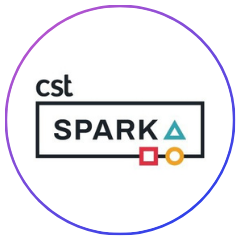Investing in Your Child's Post-Secondary Education
Sep 24, 2020 • 4 min read

Article Contents
This blog post is sponsored by CST Spark. Read our advertiser disclosure.
School is back in full swing. Different provinces are taking specific steps this back-to-school season, which is impacting students and parents alike. On top of all of the COVID-19 complexities that parents must consider, they also need to organize their finances now to cover costs for the upcoming school year. If you have a child starting high school, primary school, or even kindergarten now, you should also be thinking about post-secondary education costs in the future.
How much are tuition costs and student debt rising?
Tuition and living costs for university students in Canada seem to rise almost every year. According to Statistics Canada, Canadian undergraduate tuition fees have risen by over 30% in the past decade. In a 2018 CUSC survey of 15,000 graduating students, the average student debt was roughly $13,925. This number almost doubles to $27,929 when excluding students with no debt at all. From this data, it’s clear that rising costs and debt can be a concern for both students and their parents.
What financial options are available to students and parents?
If you’re financially planning for your child’s future education, there are options available to consider. Student loans can help cover tuition and living costs during post-secondary programs, but they can leave your kids with a hefty financial burden after graduating from university. Your kids could have a tough time achieving future career or financial goals, like getting a graduate-level degree or buying their first home. This is especially true if they’re having trouble making on-time payments on their student loans.
For high school students applying for university or college, there are scholarships, grants, and bursaries that are offered by the government and post-secondary schools. These resources are often rewarded based on achievements in academics, athletics, or extra curricular activities, so they can be difficult to obtain.
The best way you can help cover your child’s future education costs is to start saving early and plan ahead. Even if your kids are just starting kindergarten, a surefire way to prepare for future education costs is to start saving now. Opening a Registered Education Savings Plan, or an RESP, is a great first step to take.
What is an RESP?
An RESP is a smart savings tool that’s geared towards saving for a child’s post-secondary education. An RESP is a tax-advantaged account, which means your investments inside the account grow tax free. You can contribute a lifetime maximum of $50,000 per child to an RESP.
The main advantage of opening an RESP is that you can access government grants that match a portion of your contributions. The Canada Education Savings Grant (CESG) matches 20% of your annual contributions, up to $500 per year. The total contribution match you could receive from this grant is $7,200 per child. That’s a considerable amount of money you can put towards your child’s post-secondary education!
What can an RESP be used for?
RESP funds can be withdrawn and used by a student in a post-secondary education program. When your child begins university, college, or trade school, they can withdraw from your RESP and use these funds towards paying tuition costs. They can also use these funds towards other education and living costs, such as textbooks, school supplies, rent, and meals.
Where can you open an RESP?
There are organizations that focus exclusively on providing RESPs. The Canadian Scholarship Trust Foundation (CST) was the first organization in Canada to lobby for education savings plans and introduced the RESP. They also worked with the Canadian government to introduce the Canada Education Savings Grant mentioned above. CST has helped almost 600,000 Canadian families build education savings by offering RESPs with tailored RESP investment strategies and dedicated support.
What RESP does CST offer?
CST Spark (their online RESP provider), offers unique features and services to help you build your RESP and invest in your child’s future education.
The CST Bright Plan™ has many features that may be difficult to find from other providers. You can make flexible contributions starting at as little as $10/month, and you can easily change your contributions to fit your needs. Your funds are invested in a diversified portfolio that rebalances as your child ages with the goal of maximizing growth early and preserving your gains closer to graduation.
CST Spark provides on-demand support and offers a streamlined digital experience. If you’re ready to begin investing in your child’s post-secondary education, consider opening an RESP with CST Spark from the comfort of your home, in just a few minutes.
Invest in your child’s future by saving today
If you’ve only just learned about RESPs now, it’s not too late to open one today and start saving. By making contributions, receiving contribution matches from government grants, and maximizing potential returns with a provider like CST Spark, you can take the right steps towards investing in your child’s future.
CST Bright Plan is only sold by Prospectus. You can get copies of the Prospectus at cstspark.com.
Article Contents
Advertiser Disclosure
Some of the products that appear on our website are from partners who pay us a referral fee. This compensation allows Borrowell to provide services such as free access to your credit report and score.
While Borrowell receives compensation from partners for some products, unless the article or review is clearly marked “Sponsored”, products mentioned in articles and reviews are based on the author’s subjective assessment of the products’ value to readers, not compensation.
Our goal at Borrowell is to present readers with product choices that will help them achieve their financial goals but our offers do not represent all financial products. The content provided on our site is for information only and is not financial investment advice or professional advice.




